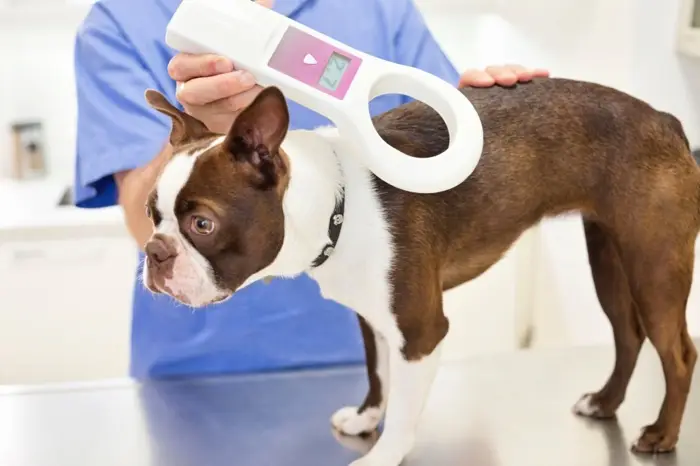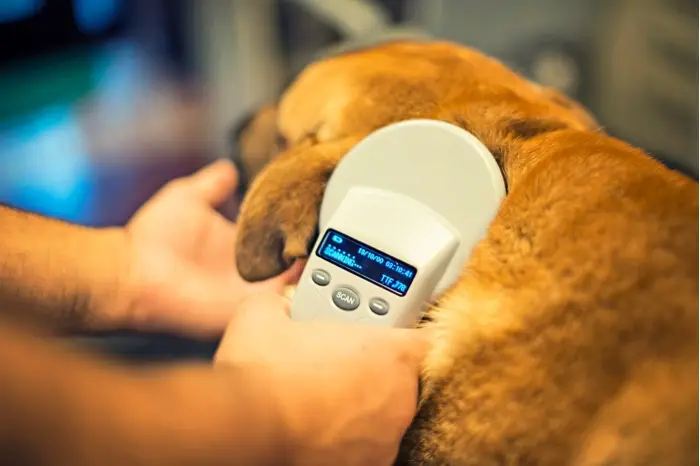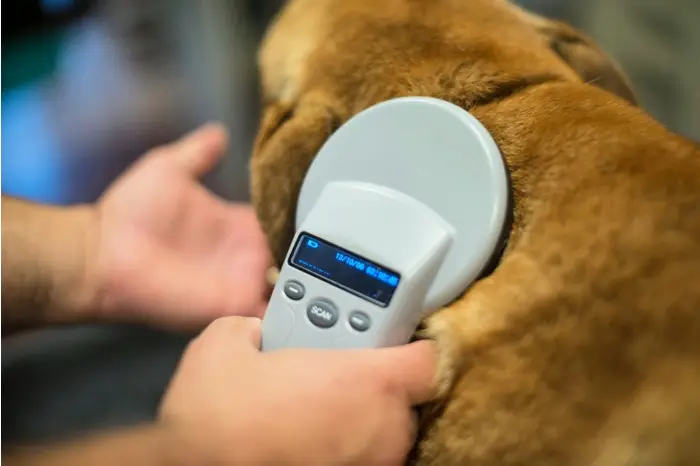Lost pets come home with Peeva.
A Step-by-Step Guide to Register Your Dog’s Chip
Lost pet situation is a nightmare for any pet owner, but there’s a beacon of hope in such distressing times: a registered microchip. A tiny device, no bigger than a grain of rice, implanted under your pet’s skin, can be the key to bringing him back home. In this guide, we’ll explore the crucial steps to register your dog’s microchip, ensuring that if the unexpected happens, your furry friend can be identified and returned to you swiftly.
Microchips have become a staple in modern pet care, offering a permanent method of identification unlike collars and tags that can fall off or become illegible. However, a microchip’s effectiveness hinges on one crucial action: registration. It’s a common misconception that implanting the chip is the final step. In reality, registering and keeping your contact information up to date is what truly makes the microchip a lifeline for your lost pet.

Understanding Microchips in Dogs
Before delving into the registration process, let’s understand what a microchip is. A pet microchip is a tiny electronic device, approximately the size of a grain of rice, that is injected under the skin of your pet, typically between the shoulder blades. Each microchip contains a unique identification number that can be read by a scanner. When a lost pet is found, veterinary clinics, shelters, or local councils can scan the pet for a microchip and access the owner’s contact information from the relevant registry. It’s important to note that microchips are not GPS devices; they do not track your pet’s location. Instead, they provide a secure and permanent method of identification.
Microchips are designed to last a lifetime. They are encased in a biocompatible material that prevents them from causing any allergic reaction or moving around once implanted. The procedure is simple and as painless as a routine vaccination. Many owners choose to have their pets microchipped during other veterinary procedures, such as spaying or neutering, but it can be done during a regular vet visit.
The role of microchips in pet identification and recovery is unparalleled. Statistics show that microchipped dogs are significantly more likely to be reunited with their owners than dogs without chips. This is especially crucial in cases of pet theft, where the presence of a microchip can be the defining factor in proving ownership and securing your pet’s return.
How to Register Dog Chip
Once your pet is microchipped, the next and most vital step is to register the chip with a national pet recovery database. Here is a step-by-step guide on how to do so:
Obtain the Microchip Number:
After implantation, your vet will provide you with the microchip’s unique identification number. Ensure you keep this number in a safe place.
Choose a Registry:
There are various pet recovery databases where you can register your pet’s microchip. Some popular ones include the American Kennel Club (AKC) Reunite, HomeAgain, and PetLink. It’s advisable to research and choose a registry that is widely recognized and used by animal shelters and veterinary offices.
Complete the Registration Process:
This typically involves visiting the registry’s website and entering your pet’s microchip number along with your contact information. It’s crucial to provide accurate and comprehensive information, including your name, address, phone number, and an emergency contact.
Keep Information Up-to-Date:
If you move house, change phone numbers, or transfer ownership of your pet, it’s imperative to update this information in the registry. A microchip is only as effective as the accuracy of the data linked to it.
Annual Checkups:
During your pet’s annual veterinary visit, ask to have the microchip scanned to ensure it’s working correctly and is still in place. This is also a good time to verify that your contact information is up to date in the microchip registry.
How to Register Your Dog’s Microchip

Understanding the distinction between implantation and registering a microchip is key. While your veterinarian takes care of the implantation, the responsibility of registering the chip falls on you, the pet owner. Here’s how to make the process as smooth as possible:
Documentation:
Keep all documentation provided by your vet post-implantation, as it contains essential information for registration.
Selecting the Right Registry:
While your vet may recommend a specific registry, it’s worth investigating which ones are most prevalent in your area. This can enhance the chances of a quick recovery if your pet is lost.
Accuracy is Key:
When registering, double-check that all the information you entered is correct. Any mistake in your contact details can create unnecessary obstacles in reuniting with your pet.
Online Registration:
Most registries offer an online registration option. It’s typically a straightforward process where you fill out an online form with the microchip number and your contact details. Ensure you complete every required field.
Confirmation:
After registration, you should receive a confirmation email or letter. This document is crucial as it’s proof of registration. Keep it in a safe place, and consider having a digital copy for easy access.
Informing Family Members:
Make sure all members of your household are aware of the microchip registration. In case your pet goes missing, anyone in the family should be able to provide the necessary information.
Extra Layer of Security:
Some pet owners choose to register their pet’s microchip in more than one registry for an added layer of protection. While this is not mandatory, it can increase the chances of your pet being identified.
Stay Informed:
Keep up with any updates or changes in the registry’s policy or process. Some registries might require an annual fee or updates, and staying informed ensures continuous protection for your pet.
Backup Plan:
In addition to the microchip, keep an up-to-date ID tag on your dog’s collar with your contact information. This provides an immediate way for someone to contact you if they find your pet.
Peace of Mind:
Once registered, you can have peace of mind knowing that you’ve taken a significant step in ensuring your pet’s safety. Remember, a registered microchip can make all the difference in a lost pet scenario.
Where Do I Register My Dog’s Microchip
Once you have your dog’s microchip number, the next crucial step is to decide where to register it. The choice of registry can affect the ease and speed with which your pet is returned to you if lost. Here’s what to consider:
Research Widely Recognized Registries:
Look for registries that are widely recognized and frequently accessed by animal shelters and veterinary offices. Some of the most reputable ones include the AKC Reunite, HomeAgain, and PetLink. These registries have extensive networks and are often the first point of contact when a lost pet is found.
Understand Registry Policies:
Different registries have varying policies. Some might be free while others charge a fee. Additionally, some registries offer extra services like 24/7 lost pet recovery support, travel assistance for found pets, and even insurance options. Choose the one that best aligns with your needs.
Ease of Use:
Consider how user-friendly the registry’s website or platform is. You want a service that is straightforward to use for both registration and updating information.
Community Involvement:
Some registries have active roles in communities, providing resources and support for lost pets and their owners. A registry that is involved in pet recovery initiatives can be a more reassuring choice.
International Coverage:
If you travel frequently with your pet, consider a registry that offers international coverage. This ensures your pet can be identified and returned to you, even when you’re abroad.
Vet and Shelter Recommendations:
Ask your veterinarian or local animal shelters which microchip registries they use or recommend. Their practical experience can guide you to make an informed choice.
How to Register My Dog’s Microchip Online
The internet has made registering your dog’s microchip easier than ever. Here’s a guide to navigate this process:

Access the Registry Website:
Visit the website of the registry you have chosen. Look for the section dedicated to new registrations.
Enter Microchip Information:
You’ll be prompted to enter the microchip number. Make sure to enter it accurately.
Fill in Your Details:
Provide your contact information, including phone numbers, address, and email. Some registries also ask for an alternate contact in case you cannot be reached.
Review and Submit:
Before submitting, double-check all the information for accuracy. Mistakes here could hinder your chances of being reunited with your pet.
Confirmation and Documentation:
Once submitted, you’ll receive a confirmation email or a physical document confirming the registration. Keep this proof in a safe place.
Regular Updates:
Most registries allow you to update your details online. Make it a habit to check and update your information, especially after any changes like moving house or changing phone numbers.
Support Services:
Explore the website for additional services they might offer, such as lost pet alerts to local shelters and veterinary offices.
Feedback:
If you find any part of the process challenging or confusing, don’t hesitate to contact the registry for assistance. Your feedback can also help them improve their services.
The Role of Peeva’s Microchips in Pet Safety
In the realm of pet safety and recovery, Peeva’s microchips stand out for their innovative technology and ease of integration. Here’s how Peeva is making a difference:
Unique Technology:
Peeva’s microchips are designed to be universally readable by all standard scanners. This reduces the chances of a microchip going undetected due to compatibility issues.
Centralised Database:
Peeva maintains a centralised database, which means your pet’s information can be accessed by any participating veterinarian or shelter, streamlining the recovery process.
Ease of Registration:
Peeva emphasises user-friendly registration processes, making it easier for pet owners to keep their contact details up to date.
Integration with Veterinary Systems:
Peeva’s system is designed to integrate seamlessly with existing veterinary practice management software, ensuring your pet’s microchip information is always accessible and current.
Education and Awareness:
Peeva is not just about technology; it’s also about educating pet owners on the importance of microchip registration and maintenance. This comprehensive approach helps create a safer environment for pets.
Continuous Innovation:
Peeva is committed to continuous improvement and innovation in the field of pet identification and recovery, ensuring they stay at the forefront of pet safety technology.
Conclusion
Remember, registering your dog’s microchip is more than just a procedural step; it’s a commitment to their safety and well-being. With the simple act of registration, you’re significantly increasing the chances of being reunited with your furry friend should they ever go astray. Consider Peeva’s microchip technology for a seamless and reliable way to protect your beloved pet. So, take a moment today to ensure your pet’s microchip is registered. It’s a small step for you, but a giant leap for your pet’s safety.
Peeva: Where Lost Pets Find Their Way Home
Transform your pet’s microchip into a lifeline. 24/7 phone support and lost pet alerts ensure your pet gets the help they need, when they need it.
You Might Be Interested In
- Health, Wellness, Nutrition
- Health, Wellness, Nutrition, Microchipping






